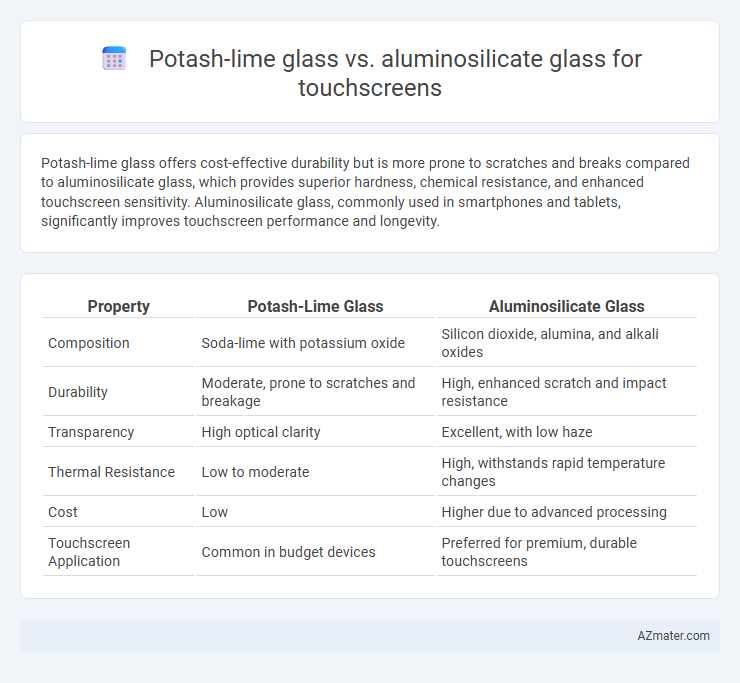Potash-lime glass offers cost-effective durability but is more prone to scratches and breaks compared to aluminosilicate glass, which provides superior hardness, chemical resistance, and enhanced touchscreen sensitivity. Aluminosilicate glass, commonly used in smartphones and tablets, significantly improves touchscreen performance and longevity.
Table of Comparison
| Property | Potash-Lime Glass | Aluminosilicate Glass |
|---|---|---|
| Composition | Soda-lime with potassium oxide | Silicon dioxide, alumina, and alkali oxides |
| Durability | Moderate, prone to scratches and breakage | High, enhanced scratch and impact resistance |
| Transparency | High optical clarity | Excellent, with low haze |
| Thermal Resistance | Low to moderate | High, withstands rapid temperature changes |
| Cost | Low | Higher due to advanced processing |
| Touchscreen Application | Common in budget devices | Preferred for premium, durable touchscreens |
Introduction: Understanding Glass Types in Touchscreens
Potash-lime glass and aluminosilicate glass are two primary materials used in touchscreen displays, each offering distinct properties that affect durability and performance. Potash-lime glass is a conventional choice valued for its cost-effectiveness and ease of manufacturing but is more prone to scratches and impact damage. Aluminosilicate glass, reinforced through chemical strengthening processes, provides superior hardness, resistance to scratches, and better shatter protection, making it ideal for high-end smartphones and devices requiring enhanced durability.
Chemical Composition: Potash-Lime vs Aluminosilicate Glass
Potash-lime glass primarily consists of silica (SiO2), potassium oxide (K2O), and calcium oxide (CaO), offering moderate chemical durability and lower melting points compared to aluminosilicate glass. Aluminosilicate glass features a higher concentration of alumina (Al2O3) and silica, enhancing its chemical strength, thermal stability, and resistance to alkali ion exchange critical for touchscreen durability. The increased alumina content in aluminosilicate glass improves hardness and scratch resistance, making it a superior choice for touchscreens that demand high performance under mechanical stress and chemical exposure.
Mechanical Strength and Durability Comparison
Aluminosilicate glass exhibits superior mechanical strength and durability compared to potash-lime glass, featuring higher resistance to scratches, impacts, and surface deformation. Its enhanced chemical composition, including aluminum oxide, provides increased toughness and thermal stability, making it ideal for touchscreen applications subjected to frequent handling and environmental stress. In contrast, potash-lime glass is more prone to chipping and scratching, limiting its effectiveness in high-performance touchscreens requiring long-term resilience.
Scratch and Impact Resistance Performance
Aluminosilicate glass exhibits superior scratch resistance compared to potash-lime glass due to its higher hardness and enhanced chemical durability, making it ideal for high-use touchscreen applications. Impact resistance is also significantly better in aluminosilicate glass, as its ion-exchange strengthening process increases surface compression, reducing the likelihood of cracks and shattering under stress. Potash-lime glass, while more cost-effective, lacks the structural integrity and scratch resilience required for modern touchscreen devices, limiting its use in high-performance electronics.
Optical Clarity and Transparency
Potash-lime glass offers good optical clarity, but aluminosilicate glass provides superior transparency due to its higher purity and fewer impurities affecting light transmission. The enhanced optical properties of aluminosilicate glass result in reduced haze and better color accuracy, crucial for touchscreen displays. Its greater resistance to scratches and chemical corrosion also maintains long-term clarity, making it a preferred choice for high-performance touchscreen devices.
Thermal Stability and Heat Resistance
Aluminosilicate glass exhibits superior thermal stability and heat resistance compared to potash-lime glass, making it ideal for touchscreens subjected to high temperatures and rapid thermal changes. Its enhanced chemical composition allows aluminosilicate glass to withstand thermal shock up to 700degC, whereas potash-lime glass typically tolerates temperatures only around 400degC before deforming or cracking. The increased thermal endurance of aluminosilicate glass results in longer-lasting, more durable touchscreen devices, especially in industrial or automotive applications exposed to extreme heat.
Manufacturing Processes and Cost Implications
Potash-lime glass, commonly used in traditional touchscreens, undergoes a batch melting process at temperatures around 1400degC, resulting in lower production costs but reduced chemical durability and scratch resistance. Aluminosilicate glass, produced through a fusion process at approximately 1900degC, offers superior strength and enhanced durability due to its higher alumina content, which increases resistance to scratches and impacts but incurs higher manufacturing expenses. The cost implications pivot on balancing the lower raw material and energy costs of potash-lime glass against the premium performance and longevity benefits delivered by aluminosilicate glass, which reduces long-term device maintenance and replacement costs.
Touch Sensitivity and User Experience
Potash-lime glass offers moderate touch sensitivity suitable for basic touchscreen applications but may exhibit slight latency and less durability under frequent use compared to aluminosilicate glass. Aluminosilicate glass, such as Corning Gorilla Glass, provides superior touch responsiveness and enhanced scratch resistance, delivering a smoother, more reliable user experience. The higher ion-exchange process of aluminosilicate glass improves both the tactile precision and longevity, making it the preferred choice for high-performance touchscreens.
Environmental and Recycling Considerations
Potash-lime glass used in touchscreens has a lower melting point, enabling energy-efficient recycling processes but contains alkali metals that can complicate chemical recovery. Aluminosilicate glass offers superior durability and scratch resistance, extending product lifespan and reducing electronic waste, yet its higher melting temperature demands more energy during recycling. Environmental impact is balanced between potash-lime glass's easier chemical processing and aluminosilicate glass's contribution to longevity, influencing sustainable material choices in touchscreen manufacturing.
Applications: Choosing the Right Glass for Device Touchscreens
Potash-lime glass is commonly used in budget-friendly touchscreen devices due to its cost-effectiveness and moderate durability, making it suitable for smartphones and tablets that require basic impact resistance. Aluminosilicate glass, such as Corning Gorilla Glass, offers superior scratch resistance, higher strength, and better chemical stability, which is ideal for premium smartphones, rugged devices, and wearables exposed to harsh environments. Selecting the right glass depends on application-specific requirements for durability, cost, and device usage conditions, with aluminosilicate glass preferred for high-performance and demanding touchscreen applications.

Infographic: Potash-lime glass vs Aluminosilicate glass for Touchscreen
 azmater.com
azmater.com